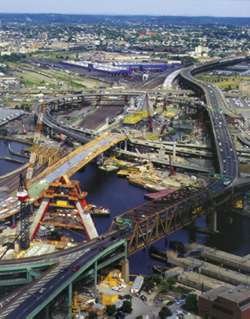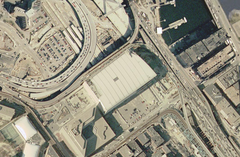Big Dig Boston Visiting Hours, Tickets & Historical Sites Guide
Date: 14/06/2025
Introduction
Boston’s Big Dig—officially the Central Artery/Tunnel Project—is a landmark of urban engineering that transformed downtown Boston. Completed in 2007, the project rerouted the city’s busy elevated highway (I-93) underground, reconnecting neighborhoods, revitalizing public spaces, and setting a global standard in city planning. Today, the Big Dig’s above-ground legacy is best experienced through the Rose Fitzgerald Kennedy Greenway, a vibrant linear park that offers lush gardens, public art, and direct access to many of Boston’s most celebrated historical sites.
This guide provides essential information for visitors, including Greenway hours, ticketing details, accessibility, transportation tips, and highlights of the Big Dig’s history and nearby attractions. Whether you’re a history enthusiast, an urban explorer, or simply looking to enjoy Boston’s green spaces, this resource will help you get the most out of your visit.
For event schedules and up-to-date information, consult the Rose Kennedy Greenway Conservancy, and consider the Audiala app for guided tours and insider tips (Meet Boston, Attractions of America).
Table of Contents
- Introduction
- What Is the Big Dig?
- Visiting the Big Dig Area: Hours, Access, and Tickets
- Guided Tours and Visitor Experiences
- Travel Tips for Visiting the Big Dig Area
- Historical Insights: The Big Dig’s Story
- Exploring the Rose Fitzgerald Kennedy Greenway
- Key Engineering and Environmental Impact
- Nearby Boston Historical Sites and Attractions
- Practical Visitor Tips
- Frequently Asked Questions (FAQ)
- Visuals and Media
- Further Reading & Resources
- Conclusion and Call to Action
What Is the Big Dig?
The Big Dig, or Central Artery/Tunnel Project, was a multi-decade initiative to move Boston’s elevated Interstate 93 underground. The project replaced an aging, congested highway with a system of tunnels and bridges, notably creating the Rose Fitzgerald Kennedy Greenway above ground. The Big Dig reconnected neighborhoods that had been divided for decades, improved traffic flow, and restored access to Boston’s waterfront.
Visiting the Big Dig Area: Hours, Access, and Tickets
Visiting Hours
- Rose Kennedy Greenway: Open daily from dawn to dusk, year-round (Rose Kennedy Greenway Official Site).
- Note: The Big Dig tunnels themselves are not open to the public for safety reasons.
Tickets & Entry
- Greenway and public spaces: Free entry; no tickets required.
- Attractions: Some features, like the Greenway Carousel, may charge a modest admission fee and operate seasonally.
- Guided tours: Various walking and biking tours are available from local operators, often requiring advance booking and a fee.
Accessibility
- The Greenway and adjacent public areas are fully wheelchair accessible, with paved paths, ramps, and accessible restrooms.
- MBTA subway stations (Green, Orange, Blue, and Silver Lines) are located nearby for convenient access (MBTA Map).
Guided Tours and Visitor Experiences
While the underground tunnels are not open to visitors, several organizations offer guided walking and bike tours emphasizing the Big Dig’s history, engineering, and impact on Boston’s cityscape. Highlights include:
- The Leonard P. Zakim Bunker Hill Memorial Bridge, a cable-stayed architectural marvel.
- Interpretive signage and memorials along the Greenway, including remnants of the original Central Artery.
- Seasonal tours focused on Boston’s infrastructure and urban renewal—check local providers for schedules.
Travel Tips for Visiting the Big Dig Area
- Best Season: Visit from spring through fall for outdoor events, markets, and pleasant weather.
- Getting There: Use the MBTA subway or commuter rail; avoid driving due to limited and expensive downtown parking.
- Photography: Top spots include the Zakim Bridge from North Point Park, Greenway fountains, and sunset views of the Boston skyline.
- What to Bring: Comfortable walking shoes, water, and a camera. Sun protection is recommended in summer.
Historical Insights: The Big Dig’s Story
Originally constructed in 1959, Boston’s Central Artery became an urban barrier and a traffic nightmare by the late 20th century. The Big Dig, initiated in the 1990s, buried this elevated highway, reuniting neighborhoods and opening up new public spaces. The project featured several engineering breakthroughs:
- Leonard P. Zakim Bunker Hill Bridge: Among the widest cable-stayed bridges globally (Wikipedia).
- Ted Williams Tunnel: Extends I-90 under Boston Harbor, the widest underwater tunnel in the world (Interesting Engineering).
- Innovations: Techniques like slurry wall construction and ground freezing were pioneered to work safely beneath the city and harbor (NASA APPEL).
Excavations also unearthed colonial-era artifacts, enriching Boston’s historical record. Many items are displayed in local museums.
Exploring the Rose Fitzgerald Kennedy Greenway
The Greenway is a 17-acre, 1.5-mile linear park offering gardens, interactive fountains, contemporary art installations, and event spaces (Attractions of America). Key features include:
- Rings Fountain and Harbor Fog: Interactive water features popular with families.
- Greenway Carousel: Features hand-carved native Massachusetts animals.
- Rotating Art Exhibits: Curated by the Greenway Conservancy and reflecting local culture.
- Food Trucks and Markets: Seasonal offerings of local and international cuisine.
For current events, consult the Greenway calendar.
Key Engineering and Environmental Impact
- Environmental Benefits: Removal of the elevated highway reduced carbon monoxide by 12% in the downtown area (Interesting Engineering).
- Urban Greening: The project planted nearly 5,000 trees and 31,000 shrubs, creating new habitats and cooling the urban core.
- Material Repurposing: Excavated earth was used to enhance local parks such as Spectacle Island.
- Economic Revitalization: 27 acres of prime real estate were reclaimed for public and commercial use.
Nearby Boston Historical Sites and Attractions
The Big Dig’s central location means easy access to some of Boston’s most iconic sites:
- Faneuil Hall & Quincy Market: Historic shopping and dining (Faneuil Hall Marketplace).
- Freedom Trail: A 2.5-mile trail linking 16 sites, including Paul Revere House and the Old State House (Nomadic Matt).
- North End: Known for Italian heritage and cuisine.
- Boston Common and Public Garden: The oldest public park in the U.S. (Boston.gov).
- New England Aquarium and Harborwalk: Waterfront attractions with scenic views (Nomadasaurus).
Practical Visitor Tips
- Transit: The MBTA “T” is the best way to reach the Greenway and nearby sites (MBTA Map).
- Parking: Limited and expensive—public transit is highly recommended.
- Accessibility: Fully wheelchair accessible, with ramps, curb cuts, and accessible restrooms.
- Safety: The area is well-patrolled and safe; dial 911 in emergencies.
Frequently Asked Questions (FAQ)
Q: Are there tickets required to visit the Big Dig or Greenway?
A: No. The Greenway and most outdoor attractions are free. Some features, like the carousel or guided tours, may charge admission.
Q: Can I tour inside the Big Dig tunnels?
A: No, for safety and operational reasons the tunnels are not open to the public.
Q: Are guided tours available?
A: Yes, various walking and bike tours highlight the Big Dig, Greenway, and surrounding historic sites.
Q: Is the Big Dig area accessible by bicycle?
A: Yes, cycling is popular and bike rentals are available.
Q: Are there family-friendly features?
A: Yes, including the Greenway Carousel, play fountains, and nearby playgrounds.
Visuals and Media
For high-quality images and maps of the Big Dig, Zakim Bridge, and Greenway, visit official sites and tourism resources. Recommended visuals include:
- Panoramic view of the Leonard P. Zakim Bunker Hill Bridge at sunset (alt: “Leonard P. Zakim Bunker Hill Memorial Bridge over Boston skyline”)
- Rose Kennedy Greenway in bloom with interactive fountains (alt: “Visitors enjoying the Rose Fitzgerald Kennedy Greenway in Boston”)
- Historical photo of the Central Artery before the Big Dig (alt: “1950s elevated Central Artery in downtown Boston”)
Further Reading & Resources
- Rose Kennedy Greenway Conservancy
- Meet Boston – Historic Boston
- Attractions of America – Boston
- MBTA Map and Schedules
- Faneuil Hall Marketplace
- Boston Common and Public Garden
Conclusion and Call to Action
The Big Dig stands as a symbol of Boston’s commitment to innovation, urban renewal, and community connection. While the tunnels themselves remain hidden, the Greenway and surrounding neighborhoods invite you to experience a city transformed—where historical legacy meets modern vibrancy.
Plan your visit today:
- Download the Audiala app for guided audio tours, maps, and insider tips.
- Explore the Rose Kennedy Greenway and nearby historic sites.
- Follow local tourism resources for up-to-date events and travel tips.
Discover how the Big Dig’s legacy shapes the heart of Boston, and immerse yourself in a unique blend of history, culture, and innovation.
References
- Big Dig Boston: Visiting Hours, Ticket Info, and Historical Insights, 2025, Audiala (Rose Kennedy Greenway)
- Transforming Boston’s Urban Landscape: A Visitor’s Guide to the Big Dig and Surrounding Historical Sites, 2025, Audiala (Meet Boston)
- Exploring the Big Dig Boston: Visiting Hours, Tickets, and Key Historical Sites, 2025, Audiala (Attractions of America)
- Big Dig Boston Visiting Hours, Tickets & Guide to Historic Sites, 2025, Audiala (Rose Kennedy Greenway)
- MBTA Map and Schedules, 2025 (MBTA)


































































































































